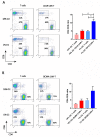Hypoxia Selectively Impairs CAR-T Cells In Vitro
- PMID: 31052261
- PMCID: PMC6562712
- DOI: 10.3390/cancers11050602
Hypoxia Selectively Impairs CAR-T Cells In Vitro
Abstract
Hypoxia is a major characteristic of the solid tumor microenvironment. To understand how chimeric antigen receptor-T cells (CAR-T cells) function in hypoxic conditions, we characterized CD19-specific and BCMA-specific human CAR-T cells generated in atmospheric (18% oxygen) and hypoxic (1% oxygen) culture for expansion, differentiation status, and CD4:CD8 ratio. CAR-T cells expanded to a much lower extent in 1% oxygen than in 18% oxygen. Hypoxic CAR-T cells also had a less differentiated phenotype and a higher CD4:CD8 ratio than atmospheric CAR-T cells. CAR-T cells were then added to antigen-positive and antigen-negative tumor cell lines at the same or lower oxygen level and characterized for cytotoxicity, cytokine and granzyme B secretion, and PD-1 upregulation. Atmospheric and hypoxic CAR-T cells exhibited comparable cytolytic activity and PD-1 upregulation; however, cytokine production and granzyme B release were greatly decreased in 1% oxygen, even when the CAR-T cells were generated in atmospheric culture. Together, these data show that at solid tumor oxygen levels, CAR-T cells are impaired in expansion, differentiation and cytokine production. These effects may contribute to the inability of CAR-T cells to eradicate solid tumors seen in many patients.
Keywords: BCMA; CAR-T; CD19; hypoxia; immunotherapy; microenvironment; tumor.
Conflict of interest statement
Robert Berahovich, Xianghong Liu, Hua Zhou, Elias Tsadik, Shirley Xu, Vita Golubovskaya and Lijun Wu are employees of Promab Biotechnologies. Other authors declare no conflict of interest.
Figures









Similar articles
-
Media evaluation for production and expansion of anti-CD19 chimeric antigen receptor T cells.Cytotherapy. 2018 Jul;20(7):941-951. doi: 10.1016/j.jcyt.2018.04.007. Epub 2018 May 30. Cytotherapy. 2018. PMID: 29859774
-
Cytolytic Activity of CAR T Cells and Maintenance of Their CD4+ Subset Is Critical for Optimal Antitumor Activity in Preclinical Solid Tumor Models.Cancers (Basel). 2021 Aug 26;13(17):4301. doi: 10.3390/cancers13174301. Cancers (Basel). 2021. PMID: 34503109 Free PMC article.
-
IL-15 Enhances the Persistence and Function of BCMA-Targeting CAR-T Cells Compared to IL-2 or IL-15/IL-7 by Limiting CAR-T Cell Dysfunction and Differentiation.Cancers (Basel). 2021 Jul 14;13(14):3534. doi: 10.3390/cancers13143534. Cancers (Basel). 2021. PMID: 34298748 Free PMC article.
-
Chimeric antigen receptor T cell (CAR-T) immunotherapy for solid tumors: lessons learned and strategies for moving forward.J Hematol Oncol. 2018 Feb 13;11(1):22. doi: 10.1186/s13045-018-0568-6. J Hematol Oncol. 2018. PMID: 29433552 Free PMC article. Review.
-
Chimeric antigen receptor T cell therapy for multiple myeloma.Inflamm Regen. 2019 Jun 4;39:10. doi: 10.1186/s41232-019-0100-6. eCollection 2019. Inflamm Regen. 2019. PMID: 31171941 Free PMC article. Review.
Cited by
-
PX-478, an HIF-1α inhibitor, impairs mesoCAR T cell antitumor function in cervical cancer.Front Oncol. 2024 Feb 15;14:1357801. doi: 10.3389/fonc.2024.1357801. eCollection 2024. Front Oncol. 2024. PMID: 38425341 Free PMC article.
-
Bispecific BCMA-CD3 Antibodies Block Multiple Myeloma Tumor Growth.Cancers (Basel). 2022 May 20;14(10):2518. doi: 10.3390/cancers14102518. Cancers (Basel). 2022. PMID: 35626122 Free PMC article.
-
Editorial on Special Issue "Immunotherapy, Tumor Microenvironment and Survival Signaling".Cancers (Basel). 2021 Dec 24;14(1):91. doi: 10.3390/cancers14010091. Cancers (Basel). 2021. PMID: 35008254 Free PMC article.
-
Hypoxia-inducible lentiviral gene expression in engineered human macrophages.J Immunother Cancer. 2022 Jun;10(6):e003770. doi: 10.1136/jitc-2021-003770. J Immunother Cancer. 2022. PMID: 35728871 Free PMC article.
-
CAR-T Cells Hit the Tumor Microenvironment: Strategies to Overcome Tumor Escape.Front Immunol. 2020 Jun 17;11:1109. doi: 10.3389/fimmu.2020.01109. eCollection 2020. Front Immunol. 2020. PMID: 32625204 Free PMC article. Review.
References
Grants and funding
LinkOut - more resources
Full Text Sources
Research Materials

